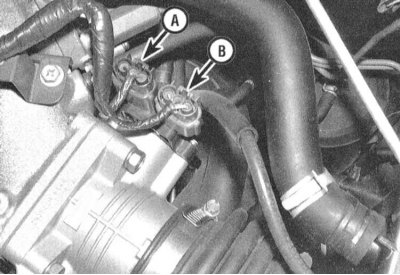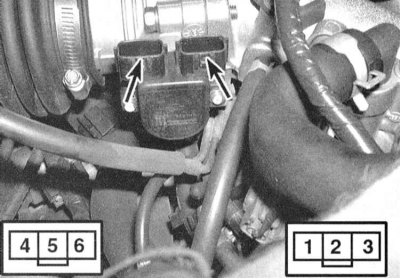Examination
Note. Performing the procedure described below may lead to the entry into the OBD memory of a malfunction, which will be highlighted by a control lamp "Check engine". Upon completion of the check and the corresponding remedial repair, do not forget to clear the system memory (see Section On-Board Diagnostic System (OBD) - the principle of operation and fault codes).

1. Before proceeding directly to the TPS test, make sure that the power supply from the PCM to the TPS is correct and that there are no ground faults. Disconnect the electrical wiring from the TPS and connect the positive probe of the voltmeter to the green-black terminal (1993 and 1994) /red (since 1995) harness wires in the connector. Connect the negative probe to the black wire terminal. With the ignition on (do not start the engine) the device should register about 5.0 V. The absence of voltage indicates an open in the PCM circuit or failure of the module itself (in the latter case, the car should be driven to a service station in order to diagnose the control module and perform the appropriate refurbishment).

2. To check if the TPS is working properly, connect an ohmmeter to terminals #2 and #3 of the sensor. Measure the TPS resistance with the throttle fully closed, then gradually open the throttle slightly while observing the change in sensor resistance. On models 1993 and 1994 issue the meter reading should change from 1.0 kΩ with the damper fully closed to 9.0 kΩ with the damper fully open. On models since 1995, no. - from 0.5 kOhm to 4.0 kOhm, respectively. The increase in resistance should be gradual.
3. Disconnect the electrical wiring from the final sensor-switch of the open / closed positions of the throttle valve. Connect an ohmmeter to terminals No. 5 and 6 of the sensor connector. Make sure that the sensor-switch is conductive to the fully closed damper, then slightly open the latter. There should be no continuity with damper open, otherwise replace TPS assembly.
Replacement
1. Disconnect the negative cable from the battery.
Attention! If the stereo system installed in the car is equipped with a security code, before disconnecting the battery, make sure that you have the correct combination to activate the equipment!
2. Remove the intake duct (see chapter Power and exhaust systems) and disconnect the electrical wiring from the TPS and the final throttle sensor-switch.
3. Remove the two mounting screws and remove the TPS assembly from the throttle body.
4. Install the new sensor in its original place and loosely screw in the mounting screws.
5. Perform TPS adjustment (see below), then finally tighten the fasteners.
Adjustment
1. Remove the intake duct (see chapter Power and exhaust systems).
2. Loosen the TPS assembly mounting screws on the throttle body.
3. On models equipped with a fully open / closed limit switch, disconnect the electrical wiring from the latter and connect an ohmmeter in accordance with the instructions in paragraph 4. insert a 0.3 mm thick feeler blade between the throttle lever and its stop screw, - the instrument should register the presence of conductivity. Now insert a 0.4 mm thick blade into the gap - this time the circuit should be open. Rotate the TPS to achieve the desired result, then securely tighten the fixing screws.
Attention! In no case do not touch the stop screw of the throttle lever - it has a factory setting and cannot be adjusted!
4. On models without a throttle end switch, probe the reverse ends of the white and black wire terminals on the TPS wiring harness connector with a voltmeter (try not to damage the terminals when inserting probes, - see Chapter Onboard electrical equipment). With the ignition on (do not start the engine) and with the throttle fully closed, the instrument should register a reading in the range of approximately 0.4 ÷ 0.5 V, otherwise make the appropriate adjustment by rotating the TPS assembly, then firmly tighten the fixing screws.